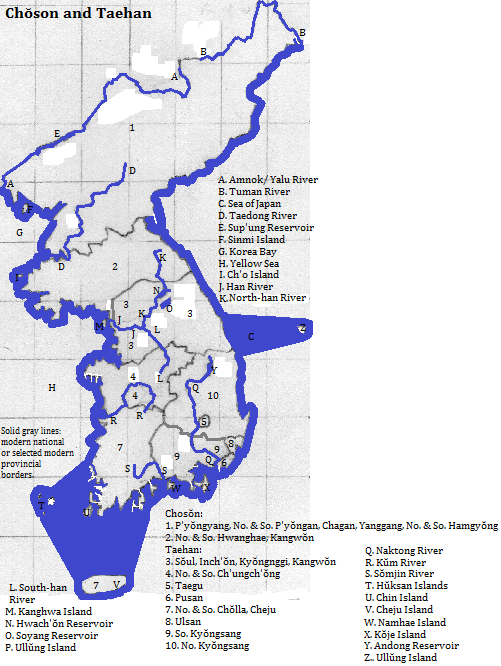
| To Duval Family Home Page | Asia |
| To Chris Home Page | To Earth (Geography Home Page) |
The Korean Peninsula separates the Yellow Sea from the Sea of Japan. The T'aebaek Mountains make a spine for the peninsula near its east coast and so most people dwell in western valleys. North of the peninsula the mountains broaden to a plateau which includes the area's tallest heights. The northwest is delimited by the Amnok
UNESCO honors one natural spot as a World Heritage Site: 'Jeju [Cheju] Volcanic Island and Lava Tubes'.

Almost all of nearly 70 million people speak Korean. In the South many learn English. Religion is complex: I. The North suppresses religious observance so it is speculating as to who would freely choose what belief; it would depend on the degree of religious education as well as ceremony and assembly. II. Christianity is the second most important formal religion in the South due mostly to American influence but--even allowing for free choice-it is not important north of the 38th parallel. III. Buddhism includes syncretic elements, so followers do not discard elements of former local religions. IV. Voluntary non-observance is quite common in the South and this makes religious statistics highly dependent on the criteria used to define adherants. V. Aside from the syncretic issue, believers in Cheondoism and other old local religions tend to be under counted or ignored, partly since the main English-language source for these international statistics are Christian organizations, who are chiefly interested in measuring the world's multinational religions.
Sŏul,
Additionally the metropolitan area of Dandong, China, spills over into the North Korea city of Sinuiju. Other northern smaller cities of note are 남포 (Namp'o or Nampo) and 개성
UNESCO honors many cultural spots as World Heritage Sites: the Complex of Koguryo Tombs (P'yŏgyang and Namp'o); the Changdeokgung Palace Complex (Sŏul); 'Gochang, Hwasun and Ganghwa Dolmen Sites' (rural North Chŏlla, rural South Chŏlla and Kangwha Island
Tourist sites not already mentioned and not wholly within a metropolitan area include: the Korean Folk Village at Yongin (metropolitan Sŏul); the Demilitarized Zone;
Before about 6000 years ago people speaking languages wholly and unarguably unrelated to Koreans lived on the peninsula and in Manchuria; they were probably related to some of the current minorities of Siberia. According to many Korean linguists, at that time Tungusic people--ancesters of Koreans and the Manchu--moved into northeast China and Korea and displaced the older culture. Around 2000 years ago Puyo was spoken in northern Korea and Manchuria and Han further south; the Han language predominated beginning in the seventh century and modern Korean evolved from that politically successful tongue. Buddhism arrived in the fourth and Christianity in the 18th centuries-both from China,
Tables of the World's Largest Cities, in Tertius Chandler, Four Thousand Years of Urban Growth, 2nd ed. (The Edwin Mellen Press, 1987) lists "Pyongyang" for 1100, 800, 650 and 430 BCE. This accords with theories still favored in the peninsula's north, but no longer in the south or by non-Korean scholars. It is likely that Chandler refers to what others call 'Asadal,' which most scholars place along the Liao River in northeastern Zhongguo (China).
north
northeast
east
southeast
south
west from South Korea
west from North Korea
northwest
1. Chosŏn is translated as Land of the Morning Calm or of the Morning Freshness.
2. Called the Yalu River in Zhongguo (China).
3. Japan in English.
4. Also a tourist attraction. Cheju Island is formally divided between Seogwipo and Cheju cities. The source for tourist attractions is http://theplacesmusttravel.blogspot.com/2011/04/10-most-popular-tourist-attractions-in.html, accessed 8/31/2015.
5. Spelled Seoul on older maps.
6. Formerly written as 開城 and formerly called 松都 (Songdo).
7. The island is part of the city-province of Inchŏn, which is part of the Sŏul metropolitan area.
8. All but one of these are within metropolitan Sŏul. The remainingn one is Jangneung at Yeongwol (rural Kangwŏn).
9. Part of the is with metropolitan Sŏul.
10. Christianity first came from Jesuit missions located in China. Buddhism was learned from China but spread under local political leadership.